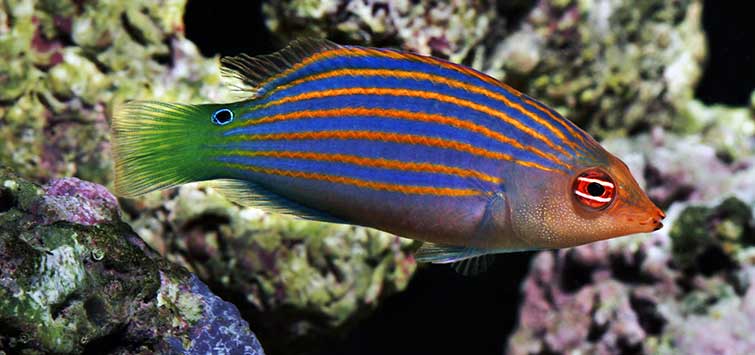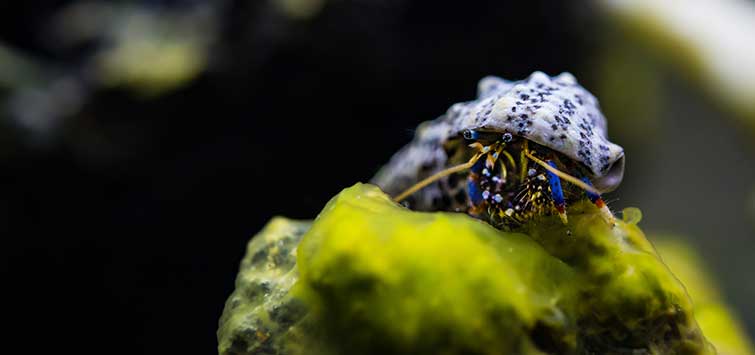The Salt Creep: Keep Those Biological Controls in Balance
Author: Jeff Kurtz
When you discover that an invasive organism has taken up residence in your aquarium, what is your first impulse? If you’re the way I used to be (admittedly not all that long ago), it’s to find some control organism that will hopefully consume the invader with haste and efficiency. In the past, when I observed any pest with the potential to harm my valued marine livestock in any way whatsoever, I wanted it gone and I wanted it gone right away!
Are Control Critters Needed?
Hair algae outbreak? Toss in a few handfuls of hermits and a slew of snails! Bubble algae uprising? Enlist the emerald crab! Aiptasia insurgency? Call in the copperband butterflyfish or peppermint shrimp! I had a “control critter” in mind for virtually every contingency.
But in more recent years, I’ve given some serious thought to the use of biological controls for managing aquarium pests and plagues. It seems the more time I spend in the marine aquarium hobby, the more I’m convinced that many of the problems we find so alarming are actually self-limiting or will, in time, be brought under control through consistent, appropriate aquarium maintenance practices.
A Plague of Planaria
It took an outbreak of flatworms to change my thinking on this topic. Some years ago, I added a few chunks of live rock from a trusted source to my established reef tank. Afterward, things went along just fine for several weeks. But then one day I noticed a smattering of rust-colored flecks on one of the rocks and the adjacent glass pane. I didn’t give much thought to it at first, assuming the flecks to be just another form of coralline algae. However, upon closer inspection, it occurred to me that the flecks were of uniform shape—and moving, to boot.
After a little online research, I concluded that these “flecks” were actually a species of flatworm, or planaria, which can reproduce to plague proportions in the aquarium. In keeping with my usual modus operandi, I searched books and the Internet for some sort of control critter, but this time I came up short. Nothing seemed especially promising for controlling flatworms. In fact, sometimes I’d observe one of the fish in my tank snap up a worm only to find it unpalatable and spit it right back out.
Staying the Course
So what did I do about this? Nothing at all—except keep up with my aquarium maintenance routine. With each partial water change, I vacuumed up as many of the tiny worms as I could. Sometimes rafts of the little buggers would rise up into the siphon all at once. For a while, the picture looked bleak. The worms kept spreading until the substrate was almost coated with them.
Critical Mass
But then a funny thing happened (funny “strange,” not funny “ha-ha”). At a certain point, the worm population reached critical mass and began to diminish. Perhaps the nutrient source that fueled the outbreak had dwindled, leaving the worms to starve. I couldn’t say for sure, but it was unmistakable that the outbreak was coming to an end. Before I could say “planarian plague,” the flatworms disappeared almost as abruptly as they arrived.
Unanswered Questions
This event begged several questions in my mind. If I had found and introduced some sort of biological control for the flatworms, how would the outcome have been different? Would I have erroneously attributed the population decline to the control organism rather than to what appeared to be a natural cycle? Would the control critter, like the flatworms, have starved once its food source vanished? Or, absent the flatworm food source, would the control critter turn its attention to desirable invertebrates in the tank? I could conclude only that, at least in this particular instance, adding one organism to control another would not have been the best course of action.
Bloomin’ Algae!
A similar circumstance arises whenever a new marine aquarium is being cycled. In this instance, unsightly algae (and I’m using this term loosely here, since all are not true algae) arrive in a series of blooms, including brown diatoms, cyanobacteria (so-called blue-green algae), and green hair algae. Each unattractive bloom may seem as if it will never end, which makes it quite tempting to introduce a control species. But if the aquarist is patient, he or she will soon see that each consecutive bloom is self-limiting and comes to an end as soon as the nutrient source required for the growth of that particular kind of alga is used up, with no help from control critters needed.
Criteria for Control Critters
Don’t get me wrong. I’m not suggesting that control critters don’t have an important place in our hobby. They most certainly do! After all, the delicate balance that is maintained on natural coral reefs is due in large part to the biological control of nuisance organisms. Just look at what happens, for example, when severe overfishing eliminates a large percentage of the herbivorous fish from a particular tract of coral reef. Before you know it, the corals are completely smothered by algae.
Balance
But the key word here, as it applies to both natural reefs and marine aquariums, is “balance.” In my humble opinion, the use of control species is perfectly acceptable—even desirable—provided the balance of the system is maintained and several additional criteria are met. They include:
The introduction of the animal does not exceed the biological capacity of your system. Ask yourself if the scales of your system will be tipped toward “biological overload” as a result of adding dozens of snails and hermit crabs to control algae, or purchasing a new butterflyfish to gobble Aiptasia anemones. Remember, overloading your system will result in a significant increase in dissolved nutrients, which may contribute to the very problem you’re trying to eradicate.
The control animal won’t starve once the food source (i.e., the target species) is eliminated. Such is the case with the Berghia verrucicornis nudibranch, which is frequently introduced to control Aiptasia. These tiny nudibranchs feed exclusively on Aiptasia, so after they do the job they’re intended to do, they will soon starve to death unless the aquarist is able to retrieve them and offer them to another hobbyist who is also battling Aiptasia. And that’s no small feat when you’re dealing with such a miniscule species that has so many places to hide.
Snails and Hermit Crabs
A similar problem can arise when we purchase large quantities of snails and hermits for algae control. They may not be obligate feeders on a particular species of algae, but due to their sheer numbers, they quickly eat themselves out of house and home, and the population eventually crashes. Of course, dead, decomposing snails and hermits mean more dissolved pollutants, which fuels more algal growth.
The introduced species won’t harm desirable livestock. This one is a challenge because experiences with particular control species vary considerably from one hobbyist to the next. For instance, accounts of using emerald crabs Mithrax sculptus to control bubble algae and hair algae in reef systems range anywhere from “this species is the greatest thing since sliced bread” to “trust this creature around your corals at your own peril.” If a control critter has a checkered history or you’ve read widely divergent accounts of its behavior around valuable livestock, observe it closely and be prepared to remove it in the event that it misbehaves or pulls a Jekyll and Hyde (i.e., behaves well for a time but then turns nasty).
Ethical Considerations
You find the control critter interesting in its own right. One could easily raise ethical questions about treating a species as if it is purely utilitarian and dispensable once its job is done. I would suggest that we should treat our control critters with the same level of care, concern, and respect that we offer our display specimens. They are, after all, an integral and fascinating component of a balanced marine system.
You’re prepared to provide for the long-term care of the control organism. This dovetails nicely with all the previous points. Say, for example, you discover that your favorite Tridacna clam is infested with parasitic pyramidellid snails. You could introduce a six-line wrasse Pseudocheilinus hexataenia, a natural predator of these snails, to keep their numbers in check. However, you should do so only if you are willing and able to accommodate, care for, and enjoy the wrasse for its entire lifetime.
Don’t Expect Miracles
Sometimes control critters do their purchasers proud, routing the enemy in short order. Other times, well, not so much. If you choose to pit one species against another, don’t expect miracles. Even different individuals of the same control critter species vary in their effectiveness, with some immediately “going to town” on the target organism and others ignoring the pest completely.
Also, keep in mind that, even when control critters are present, continued effort on your part may still be necessary to bring an outbreak or infestation under control. As anyone who has ever battled hair algae can attest, few herbivorous organisms available to aquarists will actually consume the long, tough strands of hair algae. To eradicate it, the aquarist typically must repeatedly pull and scrub away clumps of algae by hand and stay on top of those routine water changes in order to deprive the algae of dissolved nutrients. The control critters, then, help to prevent regrowth of the algae by continually grazing over all the surfaces in the aquarium.
The Final Analysis
So what should you take away from all this? Hopefully these thoughts have given you a slightly different perspective on using one organism to control another. I’m certainly not advocating that we stop using control critters for eradicating invasive pests in the marine aquarium. In fact, I’ll no doubt use them in the future when conditions are right. But I also believe that it’s important for us as conscientious aquarists to use biological controls advisedly and with the best interest of the control species—and the delicate balance of our aquarium systems—in mind.

.png?h=595&iar=0&w=2781&hash=5FD5E69473BCC22199FBFA2FB71B6033)



